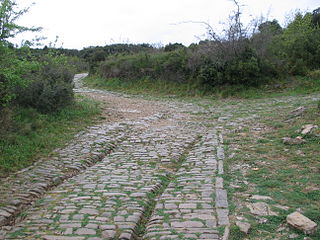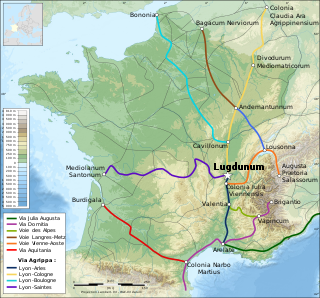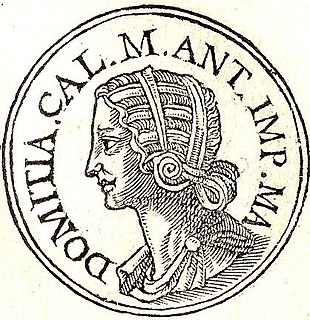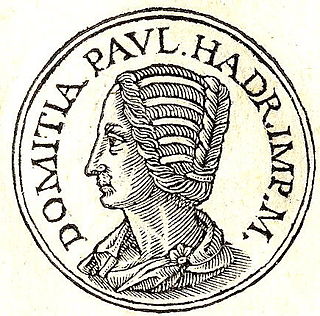Ahenobarbus was a cognomen used by a plebeian branch of the gens Domitia in the late Roman Republic and early Empire. The name means "red-beard" in Latin. According to legend, Castor and Pollux announced to one of their ancestors the victory of the Romans over the Latins at the battle of Lake Regillus, and, to confirm the truth of what they had just said, they stroked his black hair and beard, which immediately became red.

Antonia Major also known as Julia Antonia Major (Latin: Antonia Maior, PIR2 A 884) (born August/September 39 BC), also known as Antonia the Elder, was a daughter of Triumvir Mark Antony and Octavia the Younger and a relative of the first Roman emperors of the Julio-Claudian dynasty. She was a niece of the first emperor Augustus, step cousin of the emperor Tiberius, paternal great-aunt of the emperor Caligula, maternal aunt and great-aunt-in law of the emperor Claudius, and paternal grandmother and maternal great-great aunt of the emperor Nero.

The Via Domitia was the first Roman road built in Gaul, to link Italy and Hispania through Gallia Narbonensis, across what is now southern France. The route that the Romans regularised and paved was ancient when they set out to survey it, so old that it traces the mythic route travelled by Heracles.

Domitia Longina was a Roman empress and wife to the Roman emperor Domitian. She was the youngest daughter of the general and consul Gnaeus Domitius Corbulo. Domitia divorced her first husband, Lucius Aelius Lamia Plautius Aelianus in order to marry Domitian in AD 71. The marriage produced only one son, whose early death is believed to have been the cause of a temporary rift between Domitia and her husband in AD 83. She became the empress upon Domitian's accession in AD 81, and remained so until his assassination in AD 96. She is believed to have died sometime between AD 126 and AD 130.

The Via Aquitania was a Roman road created in 118 BC in the Roman province of Gaul. It started at Narbonne, where it connected to the Via Domitia. It then went toward the Atlantic Ocean, via Toulouse and Bordeaux, covering approximately 400 kilometres (250 mi).

Domitia, more commonly referred to as Domitia the Elder -- in fact no ancient source ever calls her Lepida - was the oldest child of Antonia Major and Lucius Domitius Ahenobarbus, and the oldest granddaughter to Triumvir Mark Antony by Octavia Minor, a great-niece of the Roman Emperor Augustus, second cousin and sister-in-law to the Emperor Caligula, first cousin to the Emperor Claudius, maternal aunt to the Empress Valeria Messalina, and paternal aunt to Emperor Nero. She had two younger siblings: Domitia Lepida and Gnaeus Domitius Ahenobarbus. The date of her birth is not recorded and can be only estimated as no later than 7 BC, but possibly as much as 10 years earlier, if one would allow a long delay between her birth and those of her two siblings.
Aemilia Lepida is the name of several ancient Roman women belonging to the gens Aemilia. The name was given to daughters of men belonging to the Lepidus branch of the Aemilius family. The first Aemilia Lepida to be mentioned by Roman historians was the former fiancée of the younger Cato. Subsequent Aemiliae are known because of their marriages.
Domitia is the name of women from the gens Domitius of Ancient Rome. Women from the gens include:

Julia Flavia was the daughter and only child to Roman Emperor Titus from his second marriage to the well-connected Marcia Furnilla.

Domitia Lucilla Minor, sometimes known as Domitia Calvilla or Lucilla, was a noble Roman woman who lived in the 2nd century. She is best known as the mother of the Roman Emperor Marcus Aurelius.

Paulina or Paullina was a name shared by three relatives of the Roman Emperor Hadrian: his mother, his elder sister and his niece.
Domitia was a Roman noble woman who lived in the 1st century. She was the eldest daughter to Roman Consul and General Gnaeus Domitius Corbulo and Cassia Longina, who was daughter of Junia Lepida. Her younger sister was Domitia Longina, a future Roman Empress who would marry the future Roman Emperor Domitian. Her paternal aunt was Roman Empress Milonia Caesonia.

The Roman Actor is a Caroline era stage play, a tragedy written by Philip Massinger. It was first performed in 1626, and first published in 1629. A number of critics have agreed with its author, and judged it one of Massinger's best plays.

Saint-Thibéry is a commune in the Hérault département in the Occitanie region in southern France.

The Pont Ambroix or Pont d'Ambrussum was a 1st-century BC Roman bridge in the south of France which was part of the Via Domitia. It crossed the Vidourle at Ambrussum, between today's Gallargues-le-Montueux in the Gard department and Villetelle in the Hérault department.

The University of Perpignan is a French university, located in Perpignan.

Montescot is a commune in the Pyrénées-Orientales department in southern France.
Domitia is a genus of longhorn beetles of the subfamily Lamiinae, containing the following species:

Rapala domitia is a butterfly in the family Lycaenidae. It was described by William Chapman Hewitson in 1863. It is found in the Indomalayan realm.















